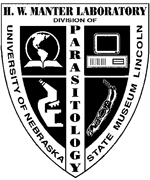Parasitology, Harold W. Manter Laboratory of

Harold W. Manter Laboratory of Parasitology: Library Materials
Document Type
Article
Date of this Version
1965
Citation
Translation number 16, College of Veterinary Medicine, University of Illinois, Urbana, Illinois, United States (16 pages)
Translation of Krylov, M. V. 1965. The development of Nuttallia tadzhikistanica Krylov et Zanina, 1962 in the tick Hyalomma anatolicum [= Razvitie Nuttallia tadzhikistanica Krylov et Zanina, 1962 v kleshche Hyalomma anatolicum]. Acta Protozoologica 3: 369-382
Translation from Russian to English by Frederick K. Plous, Jr., and edited by Norman D. Levine
Abstract
Summary
The development of Nuttallia tadzhikistanica in the larvae and nymphs of Hyalomma anatolicum was followed. In the first hours after the larvae had begun blood sucking on infected specimens of Meriones erythrourus, Nuttallia which had got into the intestire of the tick, leave erythrocytes and multiply by division into two or four individuals. Two or four hours later, mono-nuclear trophozoites occur in the haemocoel of the tick. Here their multiple division occurs. Multinucleated developmental stages of Nuttallia occur in the haemocoel during 24 hours after the larvae become detached from the host. The multinucleated stages break down into 32 trophozoites. Sometimes several tens of them arise. Multiple division may evidently be repeated several times. The multinucleated stages sometimes localize in the cytoplasm of haemocytes.
In course of 24 hours after beginning of blood sucking by the larvae in the intestine of the tick, two or four nucleated Nuttallia usually occur; these are division stages. No developmental stages of Nuttallia which might be recognized as gametes or their copulation forms, were seen.
After 48 hours the number of Nuttallia individuals in the larvae considerably diminishes, and after 96-120 hours only the amoeboid forms of Nuttallia which do not reproduce till the larvae molt are present. These are resting stages. They also occur in starving nymphs. The subsequent multiplication of Nuttallia in the nymph starts only then when the latter have begun blood sucking. The parasite then enters the salivary gland; here its growth takes place accompanied by multiple division of nuclei. On the fourth day, a great number of rod-shaped or pear-shaped trophozoites are formed in the salivary glands; these are invasive forms for the vertebrate host. The nymph cannot infect Meriones before the fourth day of blood sucking. An emulsion of larvae infected with Nuttallia, prepared 24-26 hours after the conclusion of blood sucking and injected into Meriones, failed to cause infection.
Translation number 16, College of Veterinary Medicine, University of Illinois, Urbana, Illinois, United States (16 pages)
Translation of Krylov, M. V. 1965. The development of Nuttallia tadzhikistanica Krylov et Zanina, 1962 in the tick Hyalomma anatolicum [= Razvitie Nuttallia tadzhikistanica Krylov et Zanina, 1962 v kleshche Hyalomma anatolicum]. Acta Protozoologica 3: 369-382
Translation from Russian to English by Frederick K. Plous, Jr., and edited by Norman D. Levine

